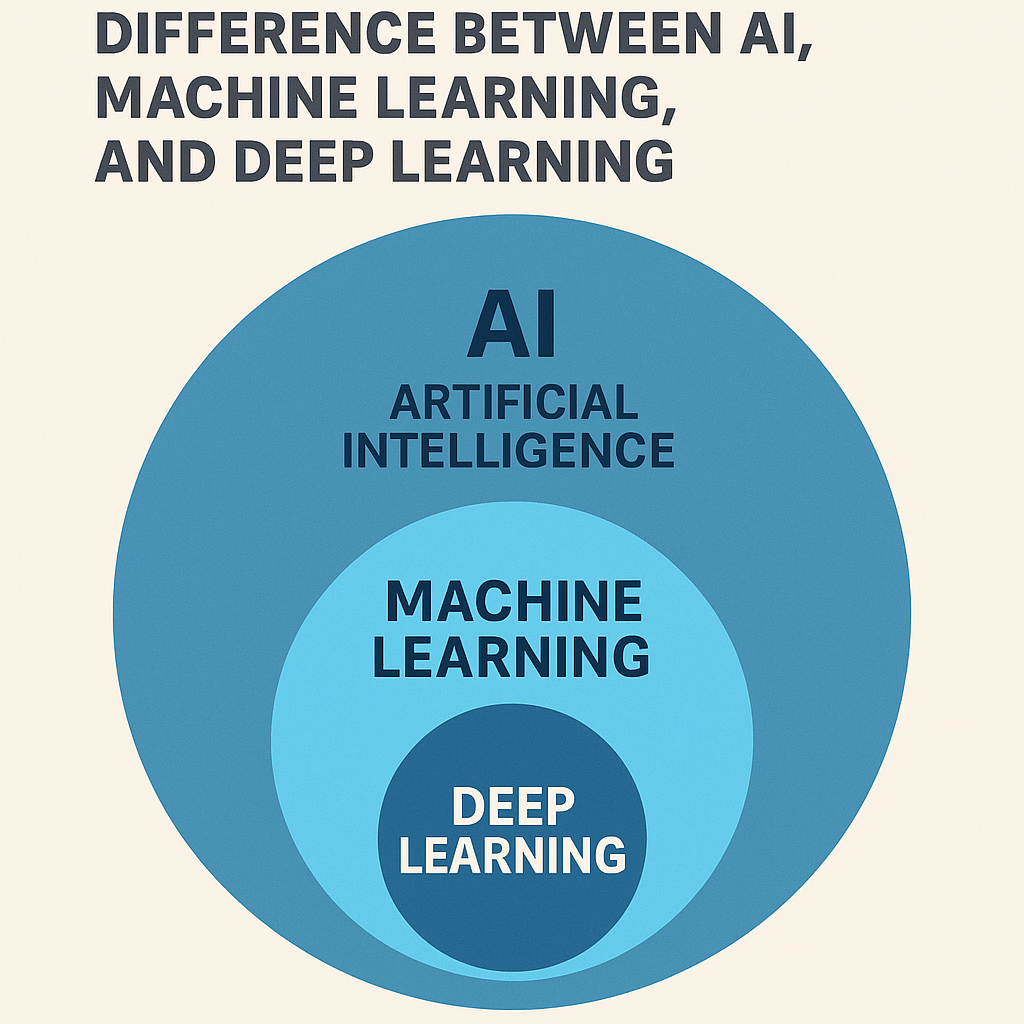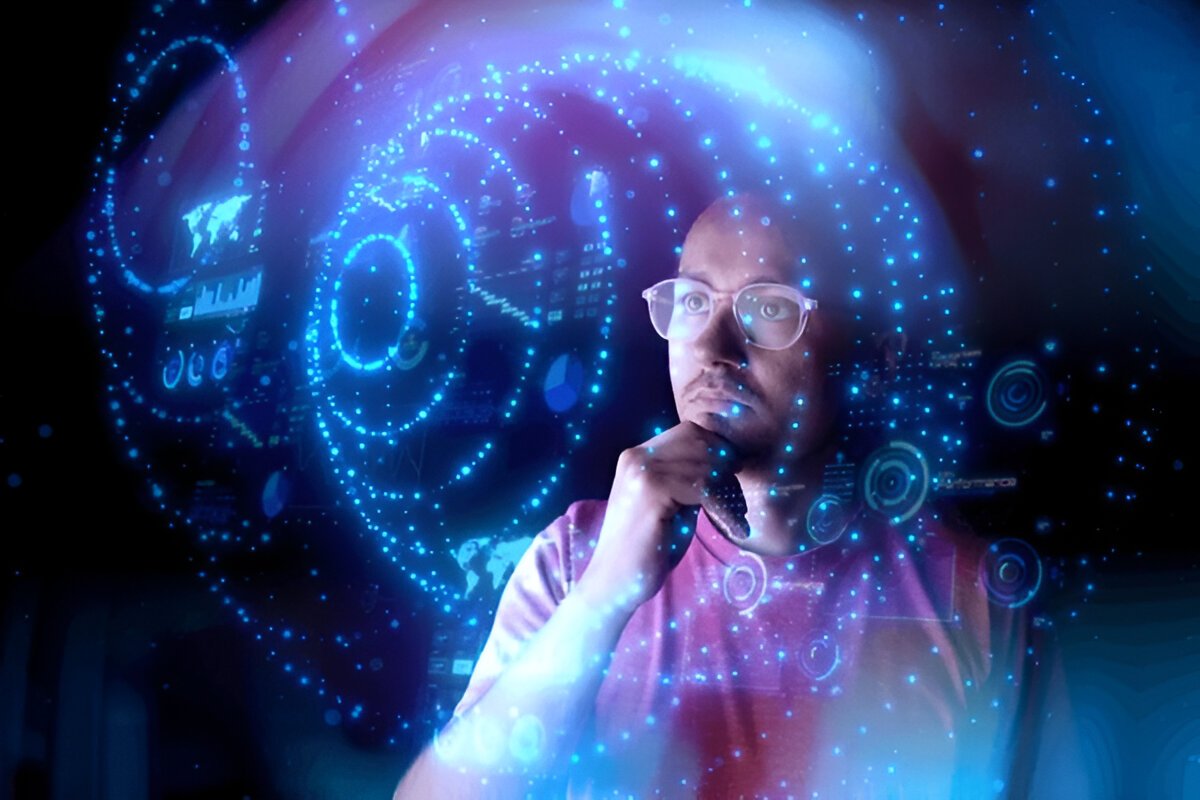Difference Between AI, Machine Learnings, and Deep Learning: Explained for Beginners

Artificial Intelligence (AI), Machine Learnings (ML), and Deep Learning (DL) are often used interchangeably, but they are not the same. Understanding their differences is crucial in today’s digital era, especially with AI tools like ChatGPT and self-driving cars making headlines. Whether you’re a student, a professional, or just curious—this guide will help you clearly understand these terms with simple language, real-world analogies, and a comparison table.
What is Artificial Intelligence (AI)?
Artificial Intelligence (AI) is a broad field of computer science focused on building systems that can perform tasks normally requiring human intelligence. These tasks include learning, reasoning, problem-solving, perception, language understanding, and decision-making.
Real-Life Examples of AI:
- Voice Assistants like Alexa or Siri
- Google Maps suggesting optimal routes
- Customer support chatbots that understand and respond intelligently
Analogy:
Think of AI as the entire car—it includes the engine, wheels, and everything needed to drive from point A to B. Machine learnings and deep learning are parts of the car that help it function better.
What is Machine Learnings (ML)?
Machine Learning is a subset of AI that gives systems the ability to learn and improve from experience without being explicitly programmed. It uses algorithms that learn from data to make predictions or decisions.
Types of Machine Learning:
- Supervised Learning: Learns from labeled data (e.g., spam vs. not spam emails)
- Unsupervised Learning: Finds patterns in unlabeled data (e.g., customer segmentation)
- Reinforcement Learning: Learns through trial and error (e.g., game-playing AIs)
Real-Life Examples:
- Netflix recommendations
- Email spam filters
- Credit scoring systems
Analogy:
If AI is the car, ML is the engine that helps it move by learning how to drive better over time based on the road it travels.
What is Deep Learning (DL)?
Deep Learning is a specialized form of machine learnings that mimics the workings of the human brain using structures called artificial neural networks. It’s particularly good at processing large volumes of unstructured data such as images, audio, and text.
Real-Life Examples:
- Facial recognition on smartphones
- Language translation (e.g., Google Translate)
- Autonomous vehicles
Analogy:
Deep learning is like a high-performance turbocharged engine inside the car—more powerful and capable of handling complex tasks, but it needs a lot more fuel (data) and maintenance (computing power).
Why Does the Difference Matter?
Understanding the distinction is important for:
- Career paths: Data science vs. deep learning engineer vs. AI researcher
- Technology adoption: Knowing what tools and skills your business needs
- Avoiding hype: Many companies claim to use “AI” when they really mean simple ML
Common Misconceptions
1. AI = ML = DL
Not true. AI is the big umbrella, ML is a branch, and DL is a deeper, more complex branch of ML.
2. AI works without data
False. Modern AI, especially ML and DL, relies heavily on vast amounts of data.
3. AI is only for tech companies
Wrong. AI is used across sectors: healthcare, agriculture, finance, education, and even art!
Real-Life Scenario: AI, ML, and DL in Action
Let’s say you use a banking app with smart fraud detection.
- AI detects suspicious behavior like multiple logins from different locations.
- ML models analyze your past spending to detect unusual transactions.
- DL models process visual data from your face to verify identity through facial recognition.
Frequently Asked Questions (FAQs)
Q1. Is deep learning better than machine learnings?
A: Not always. Deep learning is great for large, complex data sets like images or text. But for smaller, structured data, traditional ML works better and faster.
Q2. Do I need to learn deep learning to get into AI?
A: No. You can start with basic AI and ML concepts before diving into DL. Each has its own use case.
Q3. Can AI think like humans?
A: Not yet. AI can simulate decision-making but lacks consciousness, emotions, and common sense reasoning.
Q4. What languages are used in AI/ML/DL?
A: Python is the most popular, followed by R, Java, and frameworks like TensorFlow and PyTorch for deep learning.
Q5. Which is more expensive to implement?
A: Deep learning typically requires more computational power and data, making it more resource-intensive than ML or basic AI.
Final Thoughts
Understanding the difference between AI, Machine Learning, and Deep Learning is essential for navigating today’s tech-driven world. While AI is the overarching concept, ML is its functional engine, and DL is the most powerful form of that engine used in cutting-edge innovations.
Note: IndiBlogHub features both user-submitted and editorial content. We do not verify third-party contributions. Read our Disclaimer and Privacy Policyfor details.







